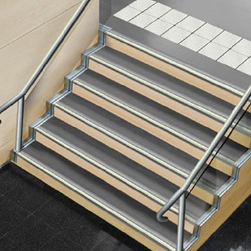









“Safe indoor staircases give residents of condominiums and apartments peace of mind. Appropriate detectable solutions play a crucial role in achieving code-mandated stair safety while facilitating easy navigation.” - Tactile Solution Canada
With tens of thousands of people inhabiting multi-story condo and apartment structures across Canada’s urban landscape, ensuring stairwell safety remains a responsibility high on building managers’ priority list. Nevertheless, tackling this challenge demands adopting proactive, standardized measures as per the diverse codes and regulations enforced nationwide for accessibility compliance. By thoughtfully choosing appropriate detectable warning systems and stair nosing solutions, facilities achieve a secure environment benefitting residents of all abilities long-term.
In this detailed blog, we explore best practices and code-compliant options for condo and apartment stair tread safety upgrades critical in multi-residential buildings. The article aims to encourage property owners and managers to prioritize life-essential precautions through informative guidelines and hands-on solution selection assistance. Let us begin our discussion by first understanding that the key code requirements are mandatory indoors.
Canada’s National Building Code and provincial building statutes outline strict stipulations that high-density residences must fulfill regarding stairways and common corridors. Some important provisions enlisted are:
Stair tread edges and landings must incorporate luminance demarcations visible in darkness per National Building Code Part 3 provisions.
Tactile Walking Surface Indicators and stair nosing in compliance with ISO 23599-1:2012 dimensions should be installed as per codes like A117.1 for detectable pathfinding.
Photoluminescent signage with Braille text is mandated at stair entry points as per NBC Emergency Lighting clauses to assist evacuation.
Materials used for luminance solutions should withstand rigorous durability testing and retain performance even after thorough cleaning cycles.
With resident safety the utmost priority, failing to adopt code-compliant solutions exposes building owners to hefty non-compliance fines or, worse, liability in preventing potential mishaps.
When upgrading aging condo and apartment staircases, the following detectable solutions best address indoor codes and usage demands:
Ecoglo Stair Edge Nosing: With a durable 15+ year lifespan, these surface-applied and cast-in-place nosing strips ably meet ISO 23599-1 profiles and integrated photoluminescence for navigation in darkness.
ArmorTile Tactile: The industry’s most extensive cast detectable dome made from diamond-hard vitrified polymer composite deliver resilient visibility and conformance to NBC flooring stipulations at competitive rates.
AccessTile FR Polymer Tiles: Engineered to eliminate future replacement through chemical and abrasion resistance, AccessTile plates simplify fire resistance, safety, and accessibility at lower costs compared to poured tiles.
EON Rubber Tiles: Durable and flexible rubber-made detectable warnings adhesive-bond to stair tread edges of all substrate materials conveniently.
Correct installation as per included manuals by certified installers is pivotal for longevity and safety purposes:
Grind non-slip treads lightly and scrupulously clean the bonding area of any sealers, moisture, or debris.
Apply specified epoxy/acrylic adhesive zig-zag along the back in thin, even coats using applicable tools.
Affix nosings with consistent gaps and alignment respecting codes.
Allow sufficient curing time before use as per drying windows.
With regards to ongoing inspections:
Conduct detailed annual checks verifying secure bonding, luminance output, and general condition.
Maintain diligent records of all works undertaken for future compliance reviews.
Communicate policies for repairs of any deteriorated sections immediately.
Besides mandatory code alignment, some vital factors also require examination for condominium and apartment applications:
Population Load Calculations: Available egress capacity must exceed the maximum potential building occupancy for emergency preparedness.
Materials Impact Resistance: Detectables should withstand impacts from daily use without breakage to uphold continuous tactile guidance longevity.
Cleaning Resilience: Solutions need cleaning chemical tolerance to facilitate routine maintenance and luminosity retention as per code standards.
Installation Disruption: Impacts on resident transit and waste disposal necessitate consideration to streamline changeover processes.
Inspection Cycles: Periodic checks and maintenance schedules uphold compliant accessibility for residents' safety long-term.
As building managers responsible for resident wellbeing and code compliance, certain best practices can foster a culture of care:
Train staff to be accessibility aware and politely assist any tenants upon request.
Educate owners and tenants with signs about designated paths of travel to limit floor obstructions.
Keep exits, landings, and paths free of any clutter, snow, ice, or moisture at all times.
Consult an accessibility auditor annually to proactively identify upgrades leveraging evolving standards.
With compassion and collective effort, multi-unit buildings can seamlessly uphold safe mobility for increasingly aging populations and those with disabilities. Our objective is to empower communities through principled stair accessibility regimes.
When modernizing stair infrastructure, choosing a system combining code prowess with enduring, low-maintenance performance grants building administrators assurance in fulfilling resident safety obligations sustainably over the coming decades. Our meticulously engineered, rigorously tested Ecoglo, AccessTile, Advantage Tile, Elan, Eon, and ArmorTile solutions exemplify this philosophy. Their internationally renowned photoluminosity, dependability, and affordable pricing inspire complete confidence for condominium and apartment upgrades. Contact us to transform indoor accessibility.
Accessibility should cease being an afterthought and instead, factor centrally into multi-residential infrastructure planning and management protocols right from initial conceptualization. Code-driven, scientifically-backed stair safety solutions, and regular inspections constitute the minimum bar to clear.
Prioritizing stairwell safety upgrades through strategic, compliant, detectable solutions provides multi-residential facilities invaluable returns on investment. Not only do property managers achieve mandatory code adherence, residents of all abilities confidently access common areas independently. By thoughtfully analyzing staircase usage demands and selecting solutions that meet codes yet are tailored for each project scope by a reputed supplier, building administrators ensure residents' wellbeing for years to come. We hope these insights help fortify stair navigation independence and emergency preparedness in the long term.
Here are answers to some commonly asked queries regarding stair safety upgrades:
Guidance and attention combo patterns deliver safe navigation assistance as per CNIB best practices.
Every 10-15 years on average, depending on material and installation location as per maintenance plans.
While affordable, the tape may not meet longevity requirements on indoor stairs subjected to heavy usage and abrasion. The best advice is to use stair-edge nosing in concordance with stair tactile.
By carefully scouring the substrate for adhesion and fastening with approved anchors suitable for edge material as per manufacturer specifications.
